Have you ever played a drum set and thought that it sounded awful? I’ve had this experience too many times to count. The culprit is typically the cymbals. However, if the drums themselves don’t sound fantastic, it’s because they’re not tuned well.
Tuning is something that beginner drummers don’t think of too much. As you progress in your drumming journey, it becomes more critical. Tuning the drums is a skill that we all need to develop.
In this guide, I’m going to break down everything you need to know about tuning and suggest some useful tools to help you.
Bottom Line Up Front: Your main tool for tuning drums is a drum key. You need it to twist the lugs that tighten the skins to the shells. If you want more accurate tuning than your listening skills, you could use a dedicated drum tuner.
These come in the form of digital and analog tuners. They measure the exact tension of the skins to give you an accurate reading. You can adjust the tensions to match when using these.
One of my favorite tuners is the DrumDial Precision Tuner. It’s an affordable mechanical tuner that many drummers I know use and love.
Tuning the Drums
I remember when I learned about how drums needed to be tuned. Several years after, I started playing, perfectly demonstrating just how important it was to me. As I’ve continued in my drumming career, I’ve realized the importance of a well-tuned drum set.
You can take a $300 kit and make it sound like a $3000 kit if you tune the drums perfectly. That’s easier said than done, though.
If you’re just as inexperienced as I was, here’s a breakdown of everything related to tuning your drums.
How to Tune Your Drums
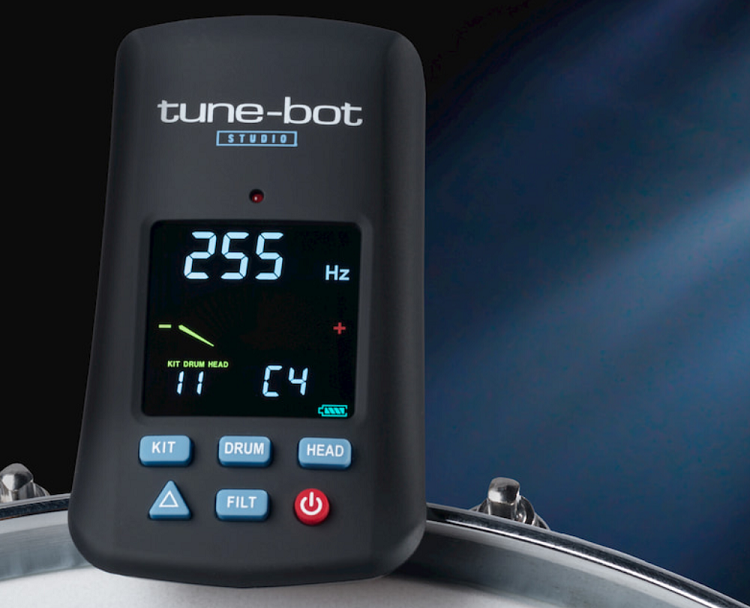
To fully understand how to tune the drums, you should know how drums are constructed. The three main parts are the drum shell, the hoops, and the drumheads that get placed on the top and bottom.
Tuning the drums refers to how tightly you connect the drumheads to the shell. The tighter the drumhead is, the higher the drum’s pitch will be. The looser it is, the lower the pitch.
However, there’s a bit more to it than that. You have several metal lugs that are lined around the shell. These are what you tighten with the use of a drum key. The general goal with tuning is that you need to have the same tension near each lug around the drum.
You can hear if the tension is the same by tapping the skin near each lug and aiming to achieve the same tone all around. If a tone is lower than you want, you’ll need to tighten the lug so that the pitch goes higher.
This gets a bit easier if you have many lugs on the drum. It’s more challenging with fewer lugs as there is more space between each one, leaving more room for the sound to change.
Batter Head vs Resonant Head
The two heads that you attach to the drums act fairly differently from each other. The top one is called the batter head. It’s the one you hit with sticks, and many drummers tend to focus on tuning it to achieve a great sound.
However, the resonant head on the bottom is just as important. While the batter head controls the initial tone you get from the drum, the resonant head controls how long the drum rings. Having a badly tuned resonant head will leave the drum with a few unbearable overtones.
You need to keep these two drumheads in mind when tuning the drum. Knowing how they affect the sound will help you decide how to approach them.
If you want no resonance at all, you could leave the resonant head off entirely. That’s how the drummers used to do it in the Classic Rock Era. Today, that’s known as a vintage tom sound. If you want to get a singing tom sound, you could tighten the resonant heads a bit more than usual.
While the batter head mainly controls pitch, it also plays an integral role in establishing how much attack the drum has. A tighter top head will have more attack than a loose one.
How Often Should You Tune Your Drums?
The tuning frequency depends on the environment you’re in and how many gigs you play. Certain weather conditions affect how the heads sit on the drums. As the weather changes, the heads will expand and contract accordingly, putting them out of tune.
I often experience all four seasons in a single day where I live. It’s a wild ride, and my drums feel the same. So, I tend to tune them more than my drummer friends who live in stable climates. Placing your drums in a ventilated area is an excellent way of avoiding this issue.
I’d also suggest tuning your drums before every gig you play. When playing for a crowd, you want to ensure that they sound as good as possible. The same can be said for studio recordings.
If you simply have your kit in a room to practice on, you won’t need to tune it as much. In this case, just keep your ears open whenever you hear some unwanted overtones. Those mean that it’s time for a tune.
Tuning for Specific Musical Styles
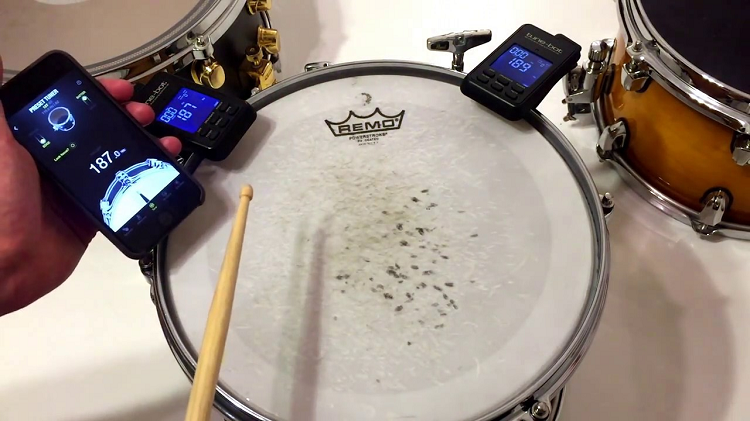
Different musical styles call for varied tuning settings. The two most extreme examples that I can think of are jazz and worship music.
Jazz drummers tend to tune their toms much higher than any other drummers. This causes the drums to resonate a fair amount, and it makes the toms feel tighter to play on. As jazz drumming is quite technical, having tighter toms is ideal.
On the opposite end of the spectrum, Christian Contemporary Music is very tom focused. The floor tom is the drum that I play the most whenever drumming in church. All the latest worship tunes have drum parts with deep and heavy tom parts.
Other styles will fit somewhere in between when it comes to tuning. Rock drummers will tune their drums on the looser side, while funk drummers may tune the drums tighter.
These rules are pretty loose, though. For example, you’ll occasionally find drummers playing jazz with intense tom tones.
Drumhead Choice
Your choice of heads is vitally essential when tuning the drums. One of my favorite things about high-quality drumheads is that they can boost the overall quality of a cheap kit by a surprising amount.
If you have low-quality heads, they will be more challenging to tune. They also won’t stay in tune for as long.
So, what are low-quality drumheads? They’re typically the heads that come with the drums when you buy a new kit. These are referred to as stock heads, and they’re never great. This is especially true with drum kits that cost under $1500.
If you replace those stock heads with top-quality products from Remo, Evans, or Aquarian, your kit will sound much better.
When choosing heads, you choose between using single-ply or double-ply heads. I’d highly suggest using double-ply heads if you’re inexperienced with tuning drums. They make things a lot easier as they already do a lot of work to eliminate overtones.
A single-ply head will often bring the truest tone out of a drum. If it hasn’t been tuned well, this won’t sound good. Typically, drummers will only use single-ply heads on professional drum kits as their tones are easier to work with.
Drum Tuning Advice
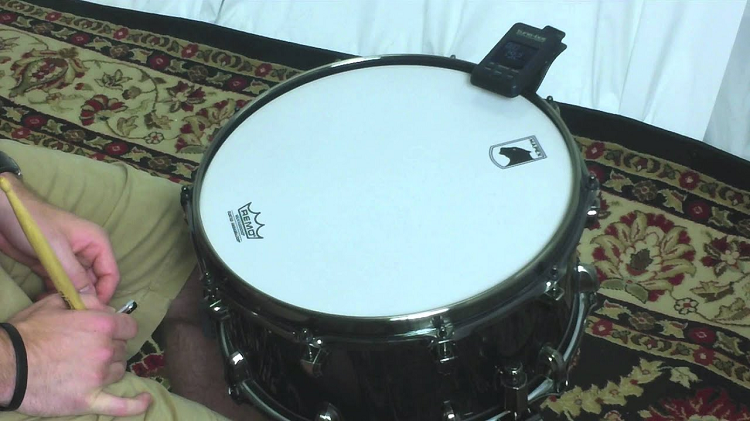
Before we look at some drum tuners, here are a few helpful tips for tuning drums:
Tune From Bottom Up
Every time you tune your drums, remove the head and place it back to tune from low pitch to high pitch. When tuning from the bottom up, it’s easier to match the tensions around all the lugs. In my experience, tuning from high pitch to low pitch takes a lot longer to achieve even tensions.
Stretch the Heads
When putting a head on a drum shell, press your hand down firmly on the center to stretch the head a bit. A stretched head will be more responsive to being tightened at all the lugs. This will make tuning slightly easier.
Always Finger Tighten First
Before pulling out drum keys and drum tuners, make sure to tighten all the lugs as tightly as you can with your fingers. You ensure that you have an even base to start from when you do this. You may even find that finger-tight tension is enough for you overall if you’re looking for deep tones.
Apply Muffling
It muffles the drums when you put any tape, gel, or objects on the batter head. Drums that are muffled more need less tuning as the overtones are already taken care of.
However, too much muffling will kill the tone of the drums. A useful trick that I learned from Mike Johnston is putting cotton balls inside the drums. This muffles the tone a bit but doesn’t sacrifice any attack.
Drum Tuning Tools
Now that you know how to tune the drums let’s look at a few tools that will help you get the job done. I’ll explain what these are, and then I’ll recommend some incredibly popular products amongst the drumming community.
Drum Keys
Drum keys are an essential tool for drummers. Without them, you can’t tune your drums. Many pieces of hardware even require drum keys to be used to adjust them. The best example of this is a memory lock that holds the stand in place to be set up in the same way.
So, every drummer needs to have multiple keys around with them. I say multiple because these things go missing all the time. I’d be embarrassed to find out how many drum keys I’ve lost in my lifetime. Thankfully, most of them are inexpensive.
Some drum keys are better to use than others when it comes to tuning. I’ve found that larger drum keys make the whole tuning experience more pleasant as there’s more room for grip. One of my favorite large keys is the Yamaha DK-30.
While I use a large key at my home practice space, it’s a bit big to take to gigs. I have a minor, inexpensive key that I’ve attached to my main set of keys that I take with me everywhere. It’s come in handy more times than I can count.
If you only tune with a drum key, you’ll need to listen closely to the drums when tuning. This often leaves space for human error, where drum tuners come in. From this point onward, I will talk about drum tuners and how useful they can be in the tuning process.
Digital Tuners
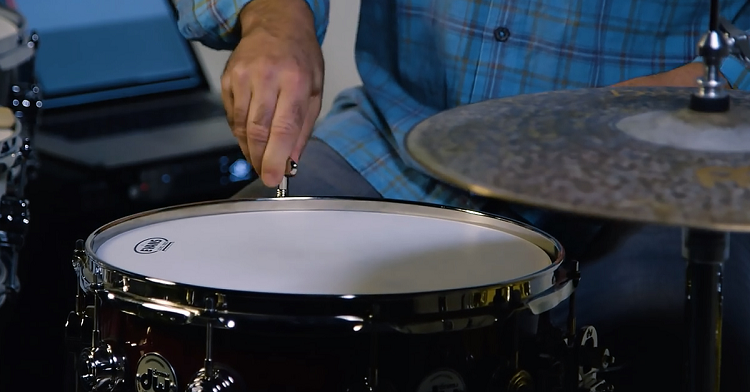
Digital tuners work by measuring the frequencies that a drum produces. It acts very similarly to a guitar tuner. With a digital tuner, you only need to place it on one part of the drum. As you hit around each tension rod, it will give a frequency. This will allow you to adjust the tension of each rod so that the frequencies are all the same.
The great thing about digital tuners is that they’re small and very easy to use. Their size allows you to store them in a stick bag, which is perfect for taking them to gigs.
The downside of them is that they’re battery-powered. This could be inconvenient if the batteries die. If you’re using a digital tuner, I’d suggest always having spare batteries packed in your stick bag as well.
Mechanical Tuners
Analog tuners have been around for a lot longer than digital tuners. They measure the tympanic pressure of a drumhead, and they need to be moved around to each lug to measure the exact tensions.
They’re more reliable than digital tuners as they don’t need batteries. They also tend to provide more accurate readings.
Their one fault is that they’re usually quite bulky. I’ve only ever used mechanical tuners in my teaching space, as taking one to a gig would weigh my backpack down unnecessarily.
The big benefit of a mechanical tuner is that you can use one to tune your drums, even if there are other noises around. As you’re measuring the tension instead of the sound, the loud lawnmower outside won’t be an issue!
Innovative Tuners
Over the years, a few companies have produced products intended to make tuning a lot easier. While many of them are quite gimmicky, I thought I should include this section to inform you that they’re out there.
If anything doesn’t fall under the category of digital or analog tuner, I like to call it an innovative tuner. I’ve only seen one fairly interesting one in the past few years, though, and I’ll mention it in the next section.
My Top Recommended Drum Tuners
Overtone Labs Tune-Bot Studio

The Tune-Bot was released in 2012, and it revolutionized the world of drum tuners with its capabilities. The Tune-Bot Studio is an upgraded version of that original product, and it’s the go-to option when looking for a digital tuner.
You get multiple settings on it, allowing you to easily dial in varied tuning ranges. My favorite aspect is that you get five slots to save tuning settings on. This means that you can move your kit somewhere else and tune it to the same tensions that it was before after looking at those saved frequency ranges.
While the Tune-Bot is built from sturdy plastic, I wouldn’t risk dropping it too often. If you’re planning on tuning at gigs, you may want to look at my next option.
Overall, many drummers have loved this tuner over the past decade, so it’s an excellent option to consider.
Pros
- Provides multiple save slots for tuning settings
- Accurately measures frequencies to help with tuning
- Sleek design
Cons
- Too flimsy and big to comfortably be taken to gigs
Overtone Labs Tune-Bot Gig

The Tune-Bot Gig solves the problem of the original version being a bit large. This version is a lot smaller and more compact, and it’s specifically designed to fit in a stick bag.
Unfortunately, you don’t get to save tuning settings with this one. Still, it offers everything else that the original Tune-Bot does.
It’s also a bit more affordable, so I’d consider getting this one instead if you don’t plan on using the kit-saving function.
The one downfall of this device is that it relies on hearing the drums to work. If you’re trying to tune during a soundcheck where your guitarist is shredding licks, it may get confused with the frequencies that it recognizes.
If you use it for tuning at gigs, you’ll need to use it before your bandmates start playing!
Pros
- Small and great to fit in a stick bag
- More affordable than the Tune-Bot Studio
- Easy to read
Cons
- Not great to use in a loud environment
Tama TW100 Tension Watch
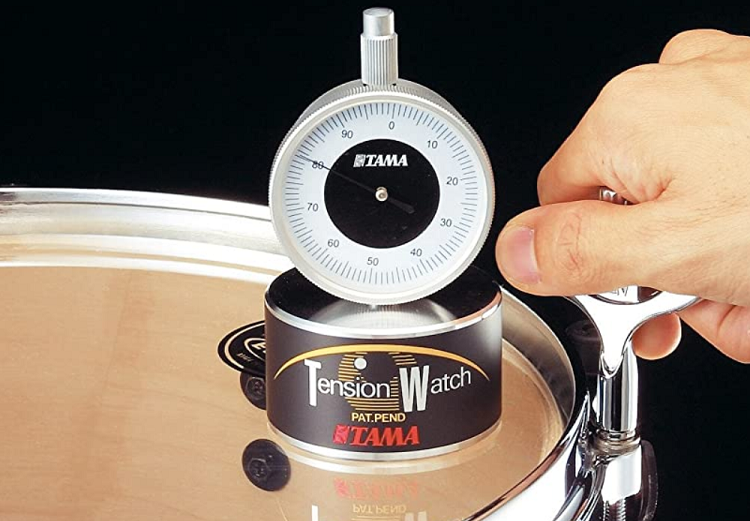
The Tama Tension Watch is as simple as it comes. It’s a mechanical drum tuner that measures the tension of the drumheads and reflects it with a pointed needle. It’s similar to scales that are used in kitchens.
While Tama sells both the TW100 and TW200 Tension Watches, I’m recommending the TW100 as it’s more competitive with its price tag to the other drum tuners here. The benefit that the TW200 is that it has a removable bumper to help with consistency. However, the TW100 will work just as well with enough practice.
I used to use a TW100 at a school where I taught drums at. I was amazed at how well it worked. It’s big and clunky, so you probably shouldn’t take this one to gigs either. It’s also slightly more expensive than the Tune-Bot Studio.
Pros
- Can be used in a loud environment
- Very accurate
- Highly durable
Cons
- Heavy
DrumDial Precision Tuner

The DrumDial Precision Tuner is arguably more popular than the Tama Tension Watch. Many drummers I know commonly refer to mechanical tuners as DrumDials.
This tuner works the same way, but it’s smaller and lighter. It’s also a fair bit more affordable. You may think that it’s the clear better option. However, I’d argue that the Tama tuner is more durable thanks to its weight.
So, I’d get this tuner if you’re happy to sacrifice sturdiness to save on costs. DrumDial also makes a digital tuner, so the company has the best of both worlds.
Pros
- More affordable than the Tama Tension Watch
- The DrumDial brand is very popular
- Option of getting a digital DrumDial tuner as well
Cons
- Not as durable as the Tama TW100 Tension Watch
Tru Tuner Rapid Head Replacement
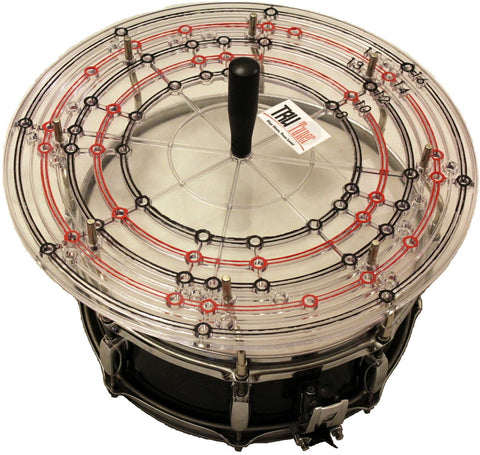
My final suggestion falls under the ‘Innovative Tuner’ category. The Tru Tuner Rapid Head Replacement System is probably the most exciting piece of drum gear that you’ve seen in a while.
The idea behind this tool is that you can attach it to a drum and remove the lugs simultaneously. In the same way, you can tighten them together to ensure they have the same tension.
I remember seeing this tuner being advertised a few years ago, and I thought it looked incredible. Unfortunately, these things are pretty challenging to find these days. You may find them in a few music stores, but the Tru Tuner website often says they’re sold out.
I put this here as a suggestion to show you how innovative tuning products can turn out. It’s a fantastic tool, and I highly recommend you buy one if you have the opportunity.
Pros
- Innovative design
- Allows you to tune your drums very quickly
- Surprisingly affordable
Cons
- Not easy to find
FAQs
Answer: Yes. A drum tuning app will work the same way that a digital tuner does. It records the frequencies of the drums you’re playing and allows you to match the tension around the head. However, drum apps never tend to be as accurate as physical tuners.
If you’re using one to get a general idea of how well your drums are tuned, go for it! If you need to tune your drums for a huge recording session, I’d consider using a dedicated drum tuner.
I know some popular drum tuning apps, iDrumTune Pro and Drumtune PRO.
Answer: It’s not a necessity. Drummers have been tuning drums without tuners for over a century. If you have an excellent ear, you’ll be able to dial your drum sound in amazingly.
However, drum tuners make the whole process a lot quicker and easier. You don’t need one, but you’d highly benefit from using one. All the drum techs for world-famous drummers use drum tuners, and that tells you how important they are.
Answer: The first step to making the process easier would be to use either a digital or mechanical drum tuner. Both will give you a direction to follow, making your tuning more consistent.
When it comes to improving at tuning, you simply need to do it often. The more you do it, the better you’ll get at recognizing the sweet spots of your drums. You’ll figure out how to tune your drums just right to get the best sounds possible.
Answer: No, you can’t tune cymbals. Cymbals don’t have a mechanism that allows you to change the tensions of their surfaces. So, you’re stuck with whatever sound they make. This is why it’s more important to invest in good cymbals than it is to invest in a good drum kit.
Even the cheapest drum kits can be tuned to sound good. Cheap cymbals, on the other hand, can’t be salvaged. If you have a budget of $1500, I’d suggest spending $1000 on cymbals and $500 on a drum kit. That’s my two cents as a drummer who’s been buying gear for two decades.
If you want to slightly alter the sound of a cymbal, you can muffle it a bit by attaching tape to the underside. You can also tape coins to the bottom to create a rivet effect.
Answer: Yes. It’s just as important to tune the resonant heads as it is to tune the batter heads. While the batter head controls the pitch and overall timbre of the drum, the bottom head controls how much it resonates.
If the bottom head is out of tune, the resonating tone will have a harsh overtone to go with it, and that’s usually what people associate out-of-tune drums with.
When the resonant head is tuned tightly, the drum will ring for much longer. It won’t ring as much when the bottom head isn’t tight. If you take that head off completely, you’ll get no resonance from the drum. Some drummers love that sound!
Conclusion
A drum tuner is something I suggest all drummers have. While tuning your drums by ear is the ultimate goal, I’d say that a tuner will help you with time and accuracy. I know several pro drummers that use their tuners to get a base level of tuning, and they fine-tune using their ears after that.
You’d just need to decide whether you want a digital or mechanical tuner. I prefer mechanical tuners, but I don’t play as many gigs as I used to, which plays a significant role in my preference. Look through the tuners I suggested and decide which one is best for you. Your drums will sound amazing once you get one!
For more interesting reading on drum gear, check out the following articles:

